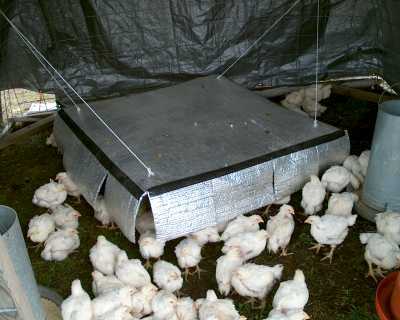Insulated Pasture Hovers: A New Old Way of Keeping Chicks Warm
by Robert Plamondon robert@plamondon.com
June 9, 2003
Insulated pasure hover. Made from aluminized bubble insulation with
a minimum of framing and hung from the ceiling.
Our farm is in Oregon's Coast Range. We get our first baby chicks in late February or early March. Our broiler chicks are brooded indoors for 2-3 weeks, then they are put onto pasture. We put our first broiler chicks on our pasture in March, when the weather is still very wet. The chicks are placed on a hill, where standing water is no problem, but the wet, blustery weather tends to chill them.
This year, we invented an insulated hover where baby chicks can go to get warm. This unheated area is kept warm by the chicks' own body temperature, and the sides of the hover help block blustery March winds.
The hover shown above is made out of eight feet of aluminized bubble insulation, which we bought on a roll four feet wide. A 4x6 foot section makes the top and two sides, and two one-foot sections make the other two sides. The sides are held on with cloth tape. Aluminized bubble insulation can be found at many hardware stores, and is sold under names like TekFoil and AstroFoil. As the names imply, it consists of one or two layers of bubble wrap bonded with aluminum foil. This makes a very lightweight and weatherproof insulation that can be cut with scissors. When I stick my hand under the hover, it feels distinctly warm just from my own reflected body heat.
For structure, two lengths of 2x2 in. lumber were cut to go diagonally across the underside of the roof. Eyebolts were screwed into the wood, and the hover was suspended from the roof of the pasture pen, as shown. The hover is hung so the sides are a couple of inches off the ground.
The chicks learn to go to the hover to warm up almost immediately on being placed in the house.
Results
The results were very gratifying. Our first batch of broilers was roughly two pounds heavier than last year! Part of this was because we started the broilers a week earlier than usual, but some of the gain is also due to the hover. The chicks are drier and more comfortable-looking in nasty weather.Putting chicks out on pasture at 2-3 weeks is important, because keeping them beyond three weeks in the brooder house tends to lead to outbreaks of coccidiosis. With the pasture hover, there is no reason to delay putting them into the pasture pens, even if the weather is cold, wet, and windy.
Pullets Need a Hover They Can Roost On
Because our pasture pens are moved by hand, we wanted to use a lightweight hover. This is okay with broilers, who lack the ability to fly up and roost on top of anything in the coop, but dual-purpose chicks will roost on top of a hover from an early age, and a flimsy hover like the one shown above would not stand the strain. For pullets, we use a hover like the one shown in our Insulated Electric Brooder page, but without electric lamps. It works great.More Off-Grid Tricks
Back before rural electrification, every conceivable method of keeping chicks warm was used, some of them very nasty. For example, gasoline-fired brooders are a good thing to avoid, and the old kerosene-lamp brooders seemed to require constant maintenance just to keep the lamps going, while coal-fired brooders, though reliable, went through over 1,000 pounds of coal for a batch of 250 chicks.
The winner, though not without downsides of its own, seems to be the "jugs of hot water" method. I first encountered this in James Dryden's Poultry Breeding and Management from 1916, pages 324-326. "A hot water jug may be used to furnish heat in a colony brooder and other brooders. A gallon jug, filed with hot water twice a day will furnish heat enough under a hover 2 feet square for fifty chicks."
I personally dislike the trick of brooding chicks in the house. It's okay for the first few days, but the chicks soon put off an incredible amount of fluff and dust. This soon gets everywhere, and it smells bad. But for, say, the first three days, it's not much of a problem. To paraphrase Benjamin Franklin, "Baby chicks, like visitors and fish, smell after three days." But the ol' "Box of chicks by the wood stove" method certainly works and can get you through an emergency.
| Get My Free Newsletter! | ||||
|
Farm & Poultry Pages
Main Page |
||||
|
My Other Sites
Norton Creek Farm |
||||
|
Read My Books!
I publish books that I believe in, under the Norton Creek Press label. |
||||






